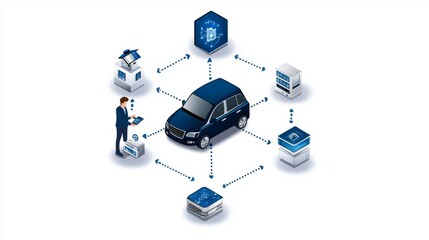An Introduction to the Future of Connected Vehicles
Imagine a world where vehicles communicate seamlessly with each other and their surroundings, leading to safer roads, reduced congestion, and efficient traffic systems. This is the promise of V2X (Vehicle-to-Everything) technology—a groundbreaking innovation that is reshaping transportation as we know it.

In this article, we will explore what V2X technology entails, how it works, its key components, and its transformative potential for the future of mobility.
Understanding V2X
What is V2X?
V2X (Vehicle-to-Everything) is a communication system that enables vehicles to interact with other vehicles, infrastructure, pedestrians, and networks in real time. It uses wireless communication technologies to exchange critical information, ensuring that vehicles can make informed decisions faster than humans.
The Key Components of V2X
- V2V (Vehicle-to-Vehicle): Communication between vehicles to share information about speed, location, and hazards.
- V2I (Vehicle-to-Infrastructure): Interaction with traffic signals, road signs, and other infrastructure for optimized traffic flow.
- V2P (Vehicle-to-Pedestrian): Alerts to pedestrians and cyclists about nearby vehicles or vice versa.
- V2N (Vehicle-to-Network): Data exchange with cloud-based systems for navigation, weather updates, and emergency alerts.
How V2X Works
V2X operates through two primary communication protocols:
- Dedicated Short-Range Communication (DSRC): A Wi-Fi-like protocol optimized for low-latency, short-range communication.
- Cellular V2X (C-V2X): Built on existing cellular networks (4G and 5G), offering broader coverage and integration with smart city systems.
Using these technologies, V2X systems constantly exchange data to create a dynamic map of the vehicle’s surroundings. This map is used for:
- Collision avoidance: Warning drivers or taking automatic action to prevent accidents.
- Traffic optimization: Providing real-time route suggestions based on traffic conditions.
The Benefits of V2X Technology
1. Enhanced Road Safety
V2X significantly reduces accidents by:
- Preventing collisions: Vehicles can alert each other about sudden stops or lane changes.
- Improving visibility: Drivers receive warnings about unseen hazards, such as vehicles hidden by blind spots or bad weather.
2. Improved Traffic Efficiency
V2X helps reduce congestion through:
- Adaptive traffic signals: Lights that adjust based on real-time traffic data.
- Dynamic rerouting: Guiding vehicles to less crowded routes, reducing travel times and fuel consumption.
3. Support for Autonomous Vehicles
For autonomous vehicles, V2X serves as a critical enabler by:
- Providing external data to supplement onboard sensors.
- Facilitating coordinated driving, such as vehicle platooning, for greater efficiency.
Real-World Applications
1. Emergency Services
V2X clears routes for ambulances and fire trucks by turning traffic lights green and alerting nearby vehicles.
2. Pedestrian Safety
Smart crosswalks equipped with V2X notify vehicles about crossing pedestrians, reducing accidents in busy areas.
3. Public Transport Integration
Buses and trains equipped with V2X share live location data with passengers and receive priority at intersections, improving schedule adherence.
Challenges to Adoption
Despite its benefits, V2X faces several challenges:
- Standardization Issues: Competing protocols (DSRC vs. C-V2X) need resolution to ensure compatibility.
- High Costs: Implementing V2X requires significant investment in infrastructure and vehicle upgrades.
- Privacy Concerns: V2X systems must safeguard user data to prevent misuse or hacking.
The Future of V2X
As technology advances, V2X is expected to become the backbone of intelligent transportation systems, contributing to:
- Zero-emission cities: By enabling eco-friendly driving patterns and integrating with electric vehicles.
- Fully autonomous vehicles: Providing the real-time communication required for safe, driverless operations.
- Global smart city initiatives: Supporting efforts to create sustainable, efficient urban environments.
Major automakers, governments, and tech companies are investing heavily in V2X to accelerate its adoption. Projects like the Tampa Connected Vehicle Pilot in the U.S. and the C-Roads Initiative in Europe are already showcasing its potential.
V2X technology represents a paradigm shift in how we think about transportation. By enabling vehicles to communicate with everything around them, V2X improves safety, reduces congestion, and sets the stage for a connected, autonomous future. As investments and innovations continue, V2X will play a pivotal role in shaping smarter, safer, and more sustainable mobility solutions worldwide.
